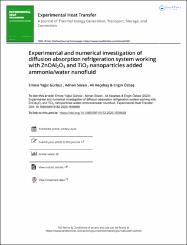Experimental and numerical investigation of diffusion absorption refrigeration system working with ZnOAl2O3 and TiO2 nanoparticles added ammonia/water nanofluid
Abstract
In this paper, the effect of various zinc oxide aluminate spinel (ZnOAl2O3) and titanium oxide (TiO2) nanoparticle concentrations on the thermal performance of the Diffusion Absorption Refrigeration (DAR) system is investigated. The main aim of the study is to increase the efficiency of DAR systems operating with low thermal performance. The first part of the study is experimentally tested on the system under the same ambient conditions in order to develop passive heat transfer using different nanofluids as working liquids, including ammonia/water solution containing different amounts (1 wt.% and 2 wt.%) of ZnOAl2O3 and TiO2 particles. In the next part of the study, the tested system is designed in MATLAB/Simulink toolbox environment to compare experimental and numerical results. The use of nanofluids can increase the surface area expansion and the heat capacity of the fluid, resulting in a significant positive increase in heat transfer. The results clarify that the use of nanofluid as working fluid in the DAR system helps quicker evaporation, which reduces operating time and increases heat transfer in the generator. Compared to a base DAR system, the nanofluid solution with a 2 wt.% ZnOAl2O3 nanoparticle concentration among other nanofluid and proportions causes a 57% increase in the coefficient of performance (COP) of DAR system.


















